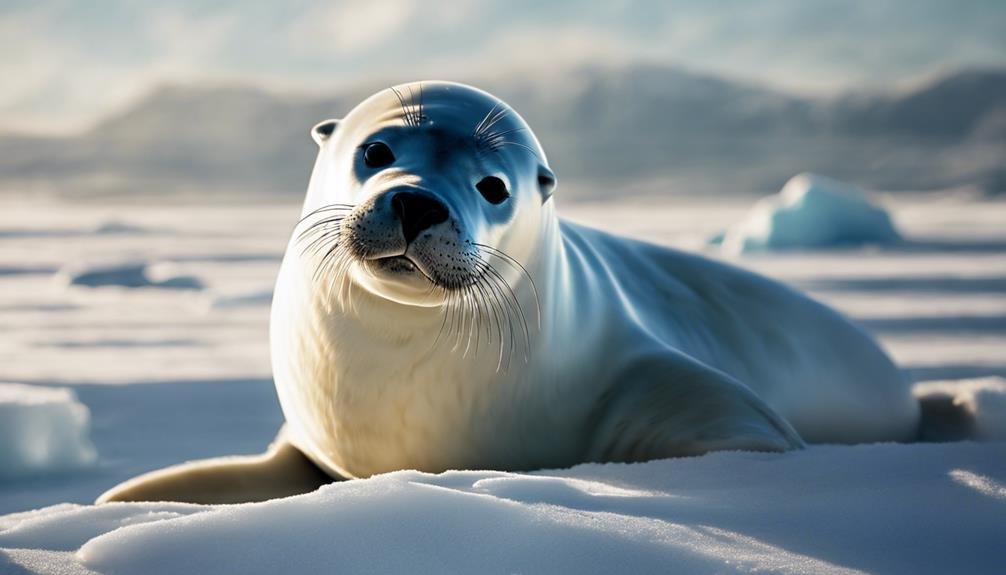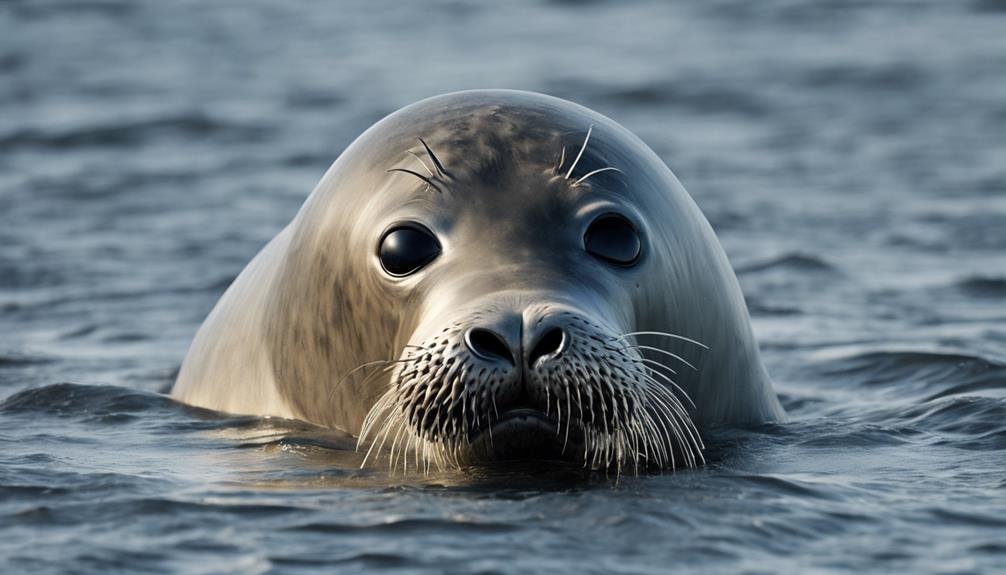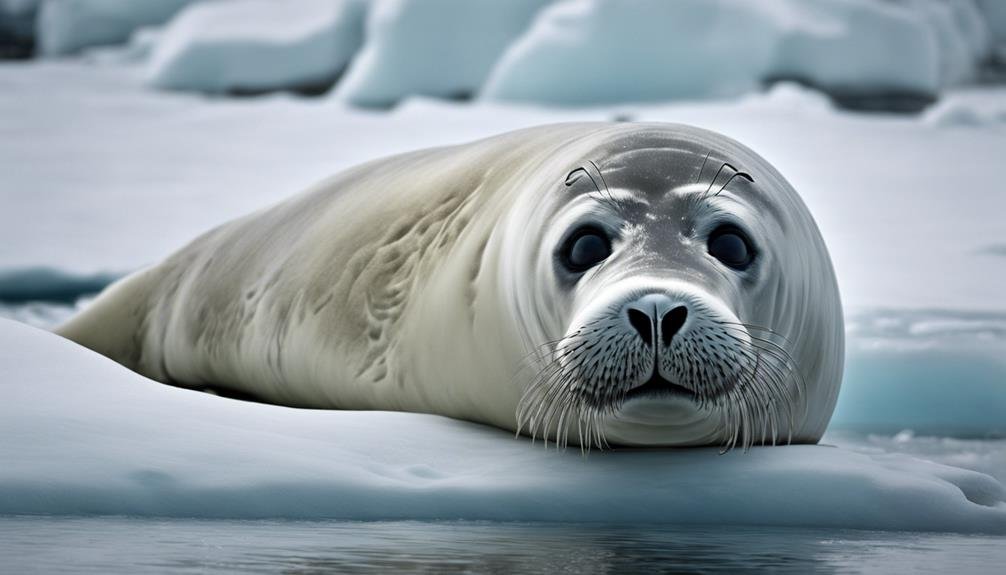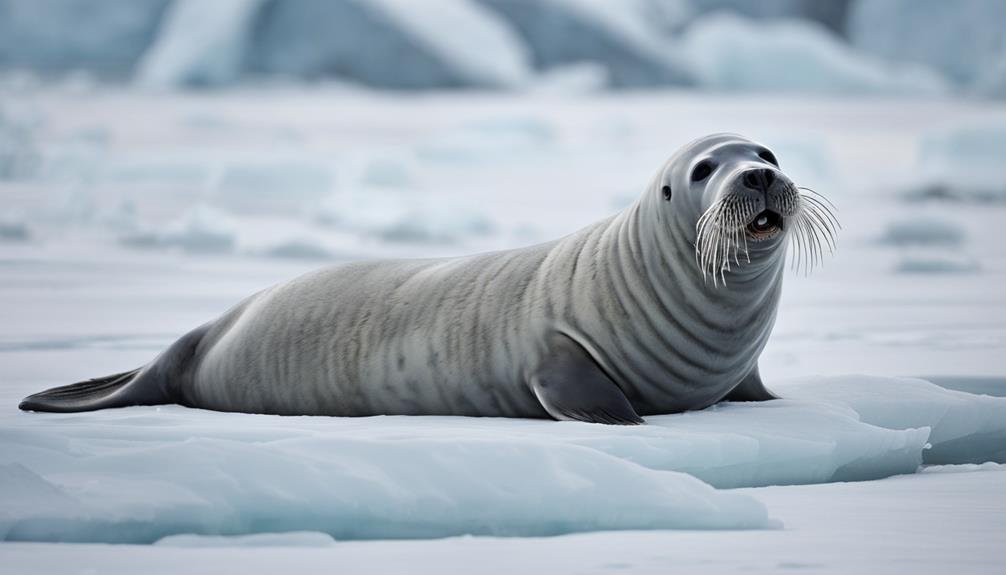How can we optimize Arctic seal habitats for conservation?
Implementing spatial management strategies to reduce human disturbances is crucial for the well-being of Arctic seal populations. Analyzing seal behavior patterns and habitat preferences can guide tailored conservation efforts effectively. Utilizing satellite tracking data and remote sensing technologies provides valuable insights into habitat usage and migration routes, enabling targeted conservation actions that promote the overall health and sustainability of Arctic seals.
Understanding the behavior and habitat needs of Arctic seals is essential for conservation. By leveraging technology and data-driven approaches, we can make a significant impact on protecting these iconic marine mammals. Ready to explore how these conservation tips can help safeguard the Arctic seal populations?
Key Takeaways
- Enhance Arctic seal habitats: Improving the quality of Arctic seal habitats is crucial for their long-term survival.
- Monitor food availability: Keeping track of food sources is essential to ensure Arctic seals have access to necessary nutrients.
- Address climate change impacts: Mitigating the effects of climate change on Arctic ecosystems is vital for protecting seal populations.
- Minimize human interactions: Reducing human disturbances in Arctic seal habitats helps in maintaining their natural behaviors and populations.
- Collaborate for conservation: Working together for conservation efforts can lead to more effective protection of Arctic seals.
- Control pollution: Implementing pollution control measures is necessary to safeguard the Arctic environment and seal habitats.
- Follow sustainable tourism guidelines: Adhering to sustainable tourism practices can help minimize negative impacts on Arctic seal habitats.
- Take immediate action: Acting promptly to protect Arctic seals and their habitats is essential for their future well-being.
- Secure Arctic environment: Ensuring the health of the Arctic ecosystem is critical for the survival of diverse wildlife, including Arctic seals.
- Protect biodiversity: Conservation efforts aimed at protecting Arctic seals contribute to the preservation of biodiversity in the region.
Habitat Evaluation and Enhancement
Seal Habitat Assessment
When evaluating Arctic seal habitats, it’s crucial to conduct comprehensive assessments to understand the quality and suitability of these environments for the marine mammals. Climate change is a significant threat to Arctic seal habitats, affecting ice formation and availability, which are essential for their survival. Assessing factors such as ice coverage, water temperature, and prey availability provides valuable insights into how these habitats are being impacted by climate change.
Importance of Habitat Quality
The current state of Arctic seal habitats plays a vital role in implementing effective conservation strategies. By identifying areas that require enhancement, researchers can support breeding, foraging, and resting activities of these marine mammals in the face of changing environmental conditions.
Enhancing Habitat Suitability
Enhancing the quality of Arctic seal habitats is necessary to ensure their continued survival. By focusing on improving ice formation, prey abundance, and sheltered resting areas, conservation efforts can help mitigate the effects of climate change on these vital environments.
Conservation Strategies
Implementing conservation strategies that prioritize the enhancement of Arctic seal habitats is essential for their long-term well-being. By addressing the challenges posed by climate change and human activities, such as shipping and resource extraction, we can work towards safeguarding these marine mammals and their habitats for future generations.
Food Availability and Distribution
Ensuring Sustainable Fisheries Management:
Sustainable management of fisheries is paramount to safeguarding the food supply for Arctic seals. By regulating fishing practices, we can prevent the depletion of essential seal food sources, such as fish and invertebrates. This proactive approach helps maintain a healthy balance in the marine ecosystem, supporting the well-being of Arctic seals.
Preserving Critical Feeding Grounds:
Protecting the vital feeding areas of Arctic seals is essential to their survival. By ensuring these grounds remain undisturbed and free from pollution, we create safe havens where seals can find abundant food resources. Preserving these habitats is crucial for maintaining a stable food supply for the seals.
Studying Prey Migration Patterns:
Understanding the movement patterns of prey species is key to optimizing seal foraging areas. By studying the migration routes of fish and invertebrates, we can identify strategic locations where seals can efficiently hunt for food. This knowledge helps in enhancing the availability of prey for Arctic seals.
Implementing Climate Change Resilience:
Implementing measures to safeguard food sources from the impacts of climate change is vital for Arctic seals. As the Arctic environment undergoes rapid changes, it’s crucial to adapt strategies to ensure the continued availability of fish and invertebrates for seals. By addressing climate-related challenges, we can secure a sustainable food supply for Arctic seals in the long term.
Climate Change Adaptations

Restoring Seal Habitats:
One crucial aspect of climate change adaptation is the implementation of habitat restoration projects in key seal habitats. By restoring these habitats, we can help mitigate environmental impacts and enhance the resilience of seal populations.
Monitoring Environmental Changes:
It is essential to monitor ice conditions and sea temperature changes in the Arctic Oceans. Understanding how these factors affect seal populations is vital for developing effective conservation strategies in the face of climate change.
Engaging Local Communities:
Collaborating with local communities is key to developing climate change adaptation strategies for marine mammals like seals. By working together, we can create plans that protect seal habitats and ensure the well-being of these animals.
Establishing Marine Protected Areas:
Creating protected marine areas plays a significant role in safeguarding crucial seal habitats from the harmful effects of climate change. These protected areas provide safe spaces for seals to thrive amidst changing environmental conditions.
Studying Seal Behavior:
Conducting research on how climate change is altering seal behavior, distribution, and reproduction patterns provides valuable insights for implementing targeted conservation efforts. By understanding these changes, we can better protect seal populations and their habitats.
Human Interaction Impact Assessment
Assessing the Impact of Human Interactions on Arctic Seal Habitats
Shipping Traffic in Seal Habitats
Shipping traffic in seal habitats is a critical factor that needs to be carefully evaluated to minimize disturbances to seal populations. By assessing the frequency and intensity of shipping activities in these areas, we can better understand how to mitigate potential disruptions.
Oil Drilling Proximity to Seal Habitats
Monitoring the proximity of oil drilling activities to seal breeding and foraging areas is essential to prevent habitat degradation. By studying the effects of oil drilling on seal habitats, we can take necessary measures to protect these vulnerable populations from harm.
Noise Pollution from Shipping and Drilling
The effects of noise pollution from shipping and drilling on seal communication and behavior shouldn’t be overlooked. Understanding how noise pollution impacts seals can help us develop strategies to reduce its negative effects on their habitats.
Contaminants from Fishing Activities
Analyzing the levels of contaminants in the environment resulting from fishing activities is crucial for assessing potential risks to seal populations. By studying the impact of contaminants on seals, we can work towards minimizing the threats posed by fishing activities to their habitats.
Ice Melt Effects on Breeding Grounds

The Impact of Arctic Ice Melt on Harp Seal Breeding Grounds
Decline in Stable Pack Ice:
Climate change-induced ice melt is significantly reducing the availability of stable pack ice crucial for harp seals to breed and nurse their pups. This decline in stable ice poses a serious threat to the breeding grounds of harp seals.
Challenges in Finding Safe Spaces:
With diminishing stable ice, harp seals are facing challenges in finding safe spaces to give birth and nurse their pups. The loss of these safe spaces increases the vulnerability of harp seal pups to predation and separation from their mothers.
Heightened Mortality Rates:
The diminishing stable pack ice leads to elevated mortality rates among harp seal pups. The lack of critical habitat for breeding and nursing exacerbates the risks faced by the seal pups, impacting their survival.
Importance of Conservation Efforts:
Protecting the breeding grounds of harp seals is essential for the survival of their populations. Conservation efforts must prioritize addressing climate change impacts to ensure the availability of stable pack ice necessary for the successful breeding and rearing of harp seal pups.
Predation Risk Management Strategies
Effective Strategies for Managing Predation Risks on Arctic Seal Populations
Predator Deterrent Devices
Using acoustic alarms can effectively reduce predation risk on Arctic seal populations by deterring predators and alerting seals to potential threats.
Designing Protected Areas
Establishing protected areas and marine reserves can help minimize human disturbance and predation pressure on seals, providing safe zones for them to thrive without constant threat.
Research on Predator-Prey Dynamics
Conducting in-depth research on predator-prey dynamics is crucial to understanding and effectively addressing predation threats to Arctic seals. This knowledge can inform targeted conservation efforts.
Sustainable Fisheries Management
Managing fisheries to prevent overfishing of seal prey species is essential for ensuring an adequate food supply for seal populations. Sustainable fishing practices can help maintain a healthy balance in the ecosystem.
Implementing these strategies can play a significant role in safeguarding Arctic seal populations from predation risks and promoting their long-term well-being in their fragile Arctic habitat.
Pollution Control Measures

Protecting Arctic Seal Habitats from Industrial Pollution
Regulations on Waste Discharge
To safeguard the pristine habitats of Arctic seals, stringent regulations must be enforced on industrial waste discharge. These regulations play a crucial role in protecting the delicate ecosystems where Arctic seals reside.
Water Quality Monitoring
Regular monitoring of water quality in Arctic regions is imperative for the early detection of pollution threats. By staying vigilant and proactive, we can swiftly address any issues that may arise and prevent harm to Arctic seal habitats.
Sustainable Industrial Practices
Encouraging sustainable practices in industries operating in the Arctic is key to minimizing the release of harmful pollutants into the environment. By prioritizing sustainability, we can reduce the impact of industrial activities on Arctic seal habitats.
Research on Pollution Impacts
Conducting research on the impacts of pollution on Arctic seals and their habitats is essential for guiding effective conservation efforts. By understanding the specific threats posed by pollution, we can develop targeted strategies to protect Arctic seals.
Community Collaboration
Collaboration with local communities and stakeholders is vital for raising awareness about the importance of pollution control in preserving Arctic seal habitats. By working together, we can educate and engage others in efforts to protect these valuable ecosystems.
Disease Monitoring and Prevention
Ensuring Seal Health: Strategies for Disease Monitoring and Prevention
Utilizing Cutting-Edge Technology for Surveillance
One vital approach to safeguarding Arctic seal populations is by harnessing advanced technology such as satellite tags and drones. These tools enable continuous monitoring of seal habitats, allowing for early detection of any signs of potential disease outbreaks.
Collaborating with Experts in the Field
Engaging with renowned research institutions and veterinary professionals is essential in establishing robust protocols for disease prevention and treatment. By leveraging their expertise, we can enhance our understanding of seal health and improve our response to emerging health threats.
Conducting Thorough Health Surveys
Regular surveys to assess the prevalence of infectious diseases and parasites among Arctic seals are crucial for early intervention. By monitoring the health status of seal populations, we can identify trends and patterns, enabling targeted preventive measures to be implemented promptly.
Implementing Biosecurity Measures in Seal Habitats
To minimize the introduction and spread of pathogens within Arctic seal habitats, stringent biosecurity measures must be put in place. By regulating human activities and enforcing protocols to prevent cross-contamination, we can create a safer environment for seals to thrive in.
Conservation Collaboration Efforts

Collaborative Conservation Strategies
Engaging Local Communities
Collaborating with local communities is essential for developing effective conservation plans for Arctic seal habitats. By involving indigenous peoples and residents in decision-making processes, we can ensure that conservation efforts align with their needs and traditions, fostering long-term sustainability and stewardship.
Government Partnerships
Working closely with governments is crucial in establishing protected marine areas and reserves for Arctic seals. Governments play a key role in implementing regulations and policies to safeguard critical feeding and breeding grounds, ensuring the preservation of these vital ecosystems for future generations.
Conservation Organization Alliances
Partnering with conservation organizations brings expertise and resources to the table. Joint initiatives can focus on sustainable fishing practices to prevent overexploitation of prey species, maintaining a healthy food source for Arctic seals. Furthermore, collaborative research projects help deepen our understanding of the ecological needs and behaviors of these marine mammals, guiding conservation efforts effectively.
Cross-Border Collaboration
Addressing transboundary conservation issues requires cross-border partnerships. By working across borders, we can tackle challenges such as sea ice preservation and the impact of oil and gas activities on Arctic seal habitats. These collaborations are essential for holistic conservation approaches that consider the interconnected nature of Arctic ecosystems.
In summary, collaborating with key stakeholders is paramount in developing comprehensive conservation plans for Arctic seal habitats. By working together, we can ensure the long-term protection of these ecosystems and the species that rely on them.
Sustainable Tourism Guidelines
Maintaining a Safe Distance from Arctic Seals
When exploring Arctic seal habitats, it’s crucial to maintain a safe distance from these majestic creatures. By avoiding close proximity, you can prevent stress and disruption to their natural behaviors. Respecting their space is essential for sustainable tourism in these delicate ecosystems.
Respecting the Peace and Quiet of Arctic Seals
To safeguard the well-being of Arctic seals, refrain from making loud noises during your visit. Quiet and peaceful surroundings are vital for these animals to thrive in their natural habitat. By keeping noise levels low, you can promote a harmonious coexistence with the seals and minimize disturbances.
Practicing Eco-Friendly Travel Habits
Embrace eco-friendly travel habits when journeying to Arctic seal habitats. Opt for sustainable transportation options to reduce your carbon footprint and minimize waste generation during your trip. By treading lightly on the environment, you can contribute to the preservation of these pristine ecosystems for future generations.
Choosing Responsible Tour Operators
Select tour operators that support local communities, prioritize conservation efforts, and educate visitors about the importance of protecting Arctic seal habitats. By partnering with responsible operators, you can contribute to sustainable tourism practices and promote the long-term well-being of these incredible marine mammals.
Frequently Asked Questions
What Are 5 Interesting Facts About Harp Seals?
What is the unique life cycle of harp seals?
- Harp seals have a fascinating life cycle that includes unique migration patterns and breeding habits.
What do harp seals eat?
- Harp seals have a diet that mainly consists of fish and invertebrates, which are crucial for their survival.
What makes harp seals captivating creatures?
- Harp seals are captivating due to their distinctive appearances and behaviors, making them a source of interest for many.
How vast is the population of harp seals in the western North Atlantic stock?
- The population of harp seals in the western North Atlantic stock is estimated to be quite large, showcasing their abundance in that region.
What are some key features of harp seals?
- Harp seals are known for their unique migration patterns, diet preferences, distinctive appearances, and significant population in the western North Atlantic stock.
Are Harp Seals Endangered 2023?
Are Arctic seal populations endangered?
Answer: Despite not being classified as endangered at the moment, Arctic seal populations are facing serious threats due to climate change. It is crucial to intensify conservation efforts to protect these species. Collaborative actions are essential to ensure the survival of these seals for future generations. Your involvement can truly make a difference.
What Are the Adaptations of the Arctic Seal?
What are some key adaptations of Arctic seals for survival?
Arctic seals have developed thermoregulation to thrive in icy waters, camouflage for evading predators, and streamlined bodies with flipper-like limbs for efficient aquatic movement.
How Can We Help Harp Seals?
Question: How can we help harp seals?
Answer: You can help harp seals by supporting sustainable fishing, advocating for speed limits in seal areas, participating in beach clean-ups, and educating others. Protecting habitats and monitoring populations are crucial for their conservation.
Conclusion
To safeguard the Arctic ecosystem and ensure the long-term survival of Arctic seals, it’s vital to implement the 10 conservation tips detailed in this article. By enhancing habitats, monitoring food availability, addressing climate change impacts, and minimizing human interactions, we can protect these vulnerable species effectively.
Collaboration, pollution control, and sustainable tourism guidelines play key roles in maintaining healthy populations and ecosystems. Taking action now is imperative to secure the future of the Arctic environment and the diverse wildlife that inhabits it.


